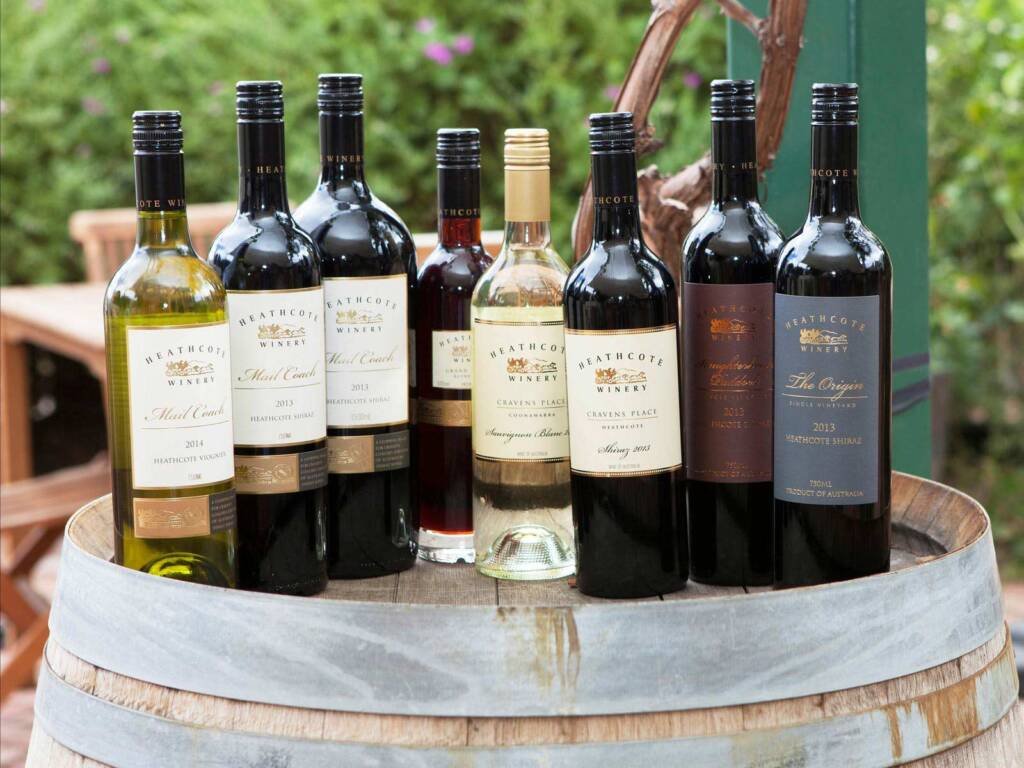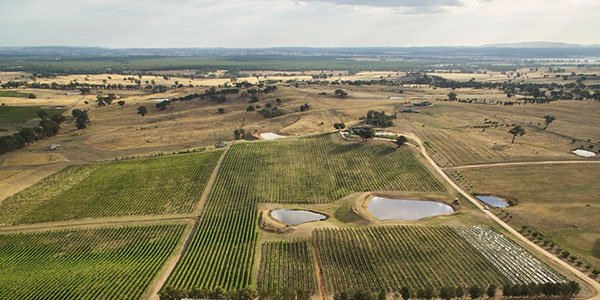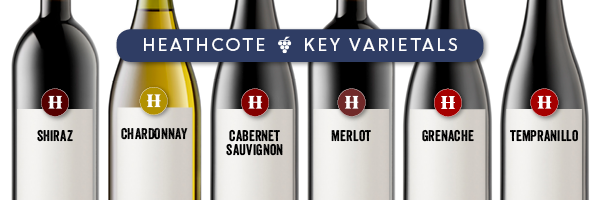Heathcote
Heathcote is a charming town in central Victoria, about 110 km north of Melbourne and 40 km southeast of Bendigo, nestled at the foot of the McIvor and McHarg Ranges. With a 2021 population of roughly 2,962, it retains a warm, rural village atmosphere.
About Hethcote, Victoria
Heathcote, Victoria is internationally renowned for its exceptional wineries, particularly those producing robust and deeply flavoured Shiraz. Nestled in the heart of central Victoria, the region’s rich, ancient Cambrian soil and continental climate provide ideal growing conditions for premium grape varieties. Shiraz dominates the landscape, with wines that are bold, spicy, and structured, often drawing comparisons to the Rhône Valley in France. Many vineyards are family-owned and offer a hands-on, boutique experience, allowing visitors to connect directly with winemakers.
Over 50 wineries operate in and around Heathcote, each bringing its own approach to viticulture and winemaking. Some of the most respected names in the area include Jasper Hill, Sanguine Estate, Heathcote Winery, Tellurian, and Merindoc. These wineries range from rustic cellar doors to architecturally designed estates, many of which provide guided tastings, vineyard tours, and curated food pairings. Sustainable farming practices are increasingly adopted, with some vineyards embracing organic and biodynamic methods.
Heathcote also hosts several wine-focused events throughout the year. The Heathcote Wine & Food Festival in October is a standout, attracting thousands of visitors for tastings, live music, and gourmet local fare. Another major event is Heathcote on Show, held during the King’s Birthday long weekend in June, where the region’s wineries open their doors with special releases, local art, and food pop-ups. Together, these elements make Heathcote a must-visit for wine lovers looking to explore one of Australia’s most character-rich wine regions.

Ancient soils in central Victoria
Heathcote Wineries
A short drive north of Melbourne takes you to Heathcote, a wine area known for its rich red soils and vibrant, flavorful red wines. After a fairly direct drive along the Northern Highway, you’ll reach the historic High Street, tranquil creek, and rugged terrain of this varied area, recognized for its unique representations of shiraz. Along with vast mountain ranges, lakes, and conservation areas, Heathcote offers a fantastic weekend getaway from the city’s hustle and bustle.
James Halliday describes a picturesque scene when he states: “Seen from above, the red soil region presents a stunning view: square or rectangular shapes of bright red alternating with lush green strips of vines.” On the ground, the slopes of the Mount Camel Range are remarkably striking, making it clear why land prices have surged.

Welcome to Heathcote
Heathcote is an extensive area featuring unique sections. The north is recognized for its rich reds, showcasing their vivid color and intense taste, whereas the south, adjacent to the cool, rugged Macedon Ranges, can yield elegant, crisp whites.
Heathcote is located approximately at the center of a triangle formed by Melbourne and the key regional centers of Bendigo and Shepparton at its corners. Alongside wine, its historic township features art galleries, local produce shops, excellent pubs, cafes, and bakeries, along with stunning bushland and traces of the area’s gold-mining history in the vicinity.
The history of wine in Heathcote
Best Wineries in Heathcote
The soils may be millions of years old, yet Heathcote is a comparatively new wine area. Similar to numerous other regions of Victoria, it has a history rich in gold, and for a significant time, wine was secondary until much later. In the 19th century, the area had some vineyards established by the early German settler Henning Rathjen, but much of that initial wine-growing territory was devastated by the vine disease phylloxera. It wasn’t until the following century that the grape cultivation sector truly picked up momentum – in the past 60 years, the narrative of wine in Heathcote has been passionately crafted.
A small group of diligent dreamers was instrumental in revitalizing the industry. Paul Osicka, a Czech vintner, was among the pioneers to establish himself in this area when it was still fairly obscure. Alongside a team of pioneers such as Albino Zuber and Bruno Pangrazio, the groundwork for present-day Heathcote was established. Ron and Elva Laughton of Jasper Hill eventually acquired Bruno’s vines – two individuals who have been crucial to the region’s success and have inspired many others to establish themselves here.
Heathcote’s wine sector experienced swift expansion in the ’70s, ’80s, and ’90s, but it was not until the early 2000s that it received its own Geographical Indication after an extended discussion on the placement of the boundary lines. With Nagambie to the east, the Macedon Ranges to the south, and Bendigo to the west, there are numerous possibilities for its route. Ultimately, the area as we recognize it was formed.
Heathcote now has over 70 wineries. Due to its unique soils and valued red wines, numerous major investors have put money into vineyards in this area – it has even drawn renowned international producers like Michel Chapoutier from France. Currently, the producers based in Heathcote comprise family-operated enterprises, biodynamic vineyards, Italian grape experts, among others.
The climate and winemaking conditions of Heathcote
The vastness of this wine region causes significant environmental variation from one location to another. Numerous subregions – extending from Tooborac to Colbinabbin – with their varied altitudes, locations, and microclimates create an intriguing array of wine styles. A notable and frequently mentioned characteristic of Heathcote is its ancient Cambrian soils, leading to wines with vibrant colors and intense flavors. Like the terra rossa found in Coonawarra, this calcium-laden substance zigzags through the area in an uneven band, bordering the Mount Ida and Mount Camel Ranges, and contributes to intricate, cellar-worthy red wines.
Heathcote has warm days and chilly nights during the harvest period. The northern region is warmer while the southern area is cooler, and this difference supports a range of diverse varieties.
Heathcote wine types
Heathcote Wines
Generally, Heathcote is recognized for its luxurious red wines. Shiraz is the prominent highlight, while Spanish and Italian varieties like grenache, tempranillo, and sangiovese are gaining popularity. Great whites are also present in specific regions, including premium chardonnay and Rhone whites such as marsanne, roussanne, and viognier.

Shiraz
Chardonnay
Heathcote is known for its vibrant, flavorful chardonnay with stone fruit notes; even with the warmer climate, the wines exhibit a notable elegance, and many are cellar-worthy.
Cabernet sauvignon
Prior to the shiraz surge in Heathcote, cabernet sauvignon was predominant, and it continues to maintain a significant presence in terms of vineyard acreage. The region’s abundant fruit can complement cabernet’s natural structure, creating very approachable styles. Wines from the north are usually robust, featuring the typical blackcurrant and cassis, whereas the south often displays mint and spice in refined, medium-bodied varieties.
Merlot
In Heathcote, Merlot is occasionally produced as single-varietal wines, but it is primarily used in blends, where its smooth tannins and sweet fruit enhance various red wines.
Grenache
Later-maturing varieties are thriving in Australia’s hot and arid wine regions, making it unsurprising to witness grenache gaining popularity in this area. Heathcote examples can be intricate, aromatic, zesty, and possess an appealing savoriness.
Tempranillo
Heathcote’s climate is ideal for tempranillo, offering the distinctive red (especially cherry) fruit notes, warm spices, and firm tannins. This type and comparable Spanish and Italian reds indicate potential for what lies ahead.
Things to do in heathcote
In addition to savoring the local wines and gathering a selection for the cellar, you can energize for vineyard tours at friendly cafes and bakeries, enjoy lunch at outstanding winery restaurants, and burn off those calories by biking or hiking through stunning bushland paths. Among the must-see natural attractions are the impressive gorges of the Pink Cliffs Reserve and the distinct ecosystem of the Heathcote-Graytown National Park.
All quotations and information in this guide are sourced from James Halliday’s Wine Atlas of Australia.
